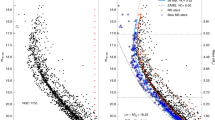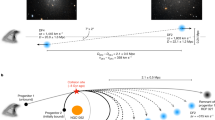Abstract
A recent analysis of a sample of close binary galaxies1 by White and Valdes2 has revealed some peculiar features: in particular, they tend to be brighter than field galaxies. Binary galaxies are important because the relative simplicity of the two-body problem in dynamics should make it possible to obtain good estimates of the masses of paired galaxies. This would help in determining whether there are massive haloes of dark, unseen matter, and in the problem area of galaxy formation. Much effort has therefore been expended (ref. 3 and refs therein), but conclusions about the existence of massive haloes and about the mass-to-light ratios have varied. Because we do not have complete information, various statistical assumptions must be made in these analyses. Detailed arguments2 suggest that one of these assumptions has been in error in previous work. We present a test which supports this claim. (The sample used here and in ref. 2 seems to be the only set of paired galaxies with quantitative selection criteria and velocity information for an unbiased subsample.) Furthermore, it was shown2 that binary galaxies are drawn from a luminosity function which has a characteristic luminosity brighter than that for field galaxies by almost one whole magnitude. We discuss one of the possible explanations and some suggestive evidence.
This is a preview of subscription content, access via your institution
Access options
Subscribe to this journal
Receive 51 print issues and online access
$199.00 per year
only $3.90 per issue
Buy this article
- Purchase on Springer Link
- Instant access to full article PDF
Prices may be subject to local taxes which are calculated during checkout
Similar content being viewed by others
References
Turner, E. L. Astrophys. J. 208, 20 (1976).
White, S. D. M. & Valdes, F. Mon. Not. R. astr. Soc. (in the press).
Turner, E. L. Astrophys. J. 208, 304 (1976).
Peterson, S. D. thesis, Cornell Univ. (1978).
Noerdlinger, P. D. Astrophys. J. 229, 877 (1979).
Schmidt, M. Astrophys. J. 151, 393 (1968).
White, S. D. M. & Sharp, N. A. Nature 269, 395 (1977).
Sharp, N. A., Lin, D. N. C. & White, S. D. M. Mon. Not. R. astr. Soc. 187, 287 (1979).
Larson, R. B. & Tinsley, B. M. Astrophys. J. 219, 46 (1978).
Holmberg, E. Medd Lund. Astr. Obs. Ser II, No. 136 (1958).
White, S. D. M. Mon. Not. R. astr. Soc. 184, 185 (1978).
Gott, J. R. III & Turner, E. L. Astrophys. J. Lett. 232, L79 (1979).
Author information
Authors and Affiliations
Rights and permissions
About this article
Cite this article
Sharp, N., Jones, B. Peculiarities of binary galaxies. Nature 283, 275–277 (1980). https://doi.org/10.1038/283275a0
Received:
Accepted:
Issue Date:
DOI: https://doi.org/10.1038/283275a0
This article is cited by
-
Interacting galaxies: Observational and theoretical aspects
Astrophysics (1994)
Comments
By submitting a comment you agree to abide by our Terms and Community Guidelines. If you find something abusive or that does not comply with our terms or guidelines please flag it as inappropriate.



